 In 2010, I visited the town of Rose in Cumberland County, Nova Scotia, to meet the nieces and nephew of Ada Lophemia (Halliday) Clark. Ada was the second wife of my great-grandfather Thomas William Clark of Moncton, New Brunswick. Within the walls of their ancestral home in Rose I heard stories of a great-grandfather who died more than a quarter-century before I was born, a man that my own father only mentioned by name, and whose face is still unknown to me. No photograph is known to exist of my great-grandfather. Nonetheless, through genealogical research and family stories I have been able to draw a picture of what he was like, with a rough sense of his life story. Continue reading A price beyond rubies
In 2010, I visited the town of Rose in Cumberland County, Nova Scotia, to meet the nieces and nephew of Ada Lophemia (Halliday) Clark. Ada was the second wife of my great-grandfather Thomas William Clark of Moncton, New Brunswick. Within the walls of their ancestral home in Rose I heard stories of a great-grandfather who died more than a quarter-century before I was born, a man that my own father only mentioned by name, and whose face is still unknown to me. No photograph is known to exist of my great-grandfather. Nonetheless, through genealogical research and family stories I have been able to draw a picture of what he was like, with a rough sense of his life story. Continue reading A price beyond rubies
Tag Archives: International genealogical research
The introduction of photography

Perhaps more than any other event, the introduction of photography altered how individuals were memorialized and are remembered. While portraits have been produced for thousands of years, photographic images were first introduced about 1838 and the first known photograph to contain people was produced between April and May of that year.[1] This photograph is of the Boulevard du Temple in Paris, and due to the long exposure time of about ten to twelve minutes, all people in the photograph moved and avoided being captured in the image, with the exception of a man having his shoes shined who remained still for the length of the exposure.[2] Continue reading The introduction of photography
Unintended consequences
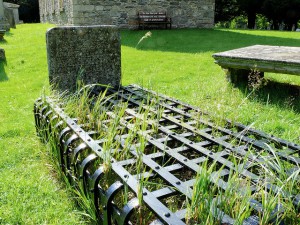 After the turn of the nineteenth century, the number of medical schools around the world increased significantly. While the increase in these institutions led to monumental developments in the medical field, it also had previously unforeseen consequences. One such consequence was a shortage of bodies for dissection and examination. Continue reading Unintended consequences
After the turn of the nineteenth century, the number of medical schools around the world increased significantly. While the increase in these institutions led to monumental developments in the medical field, it also had previously unforeseen consequences. One such consequence was a shortage of bodies for dissection and examination. Continue reading Unintended consequences
Finding a better life
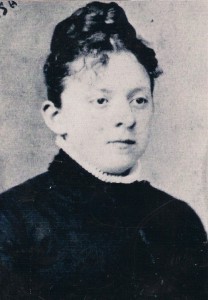
It is said time and time again that our immigrant ancestors came to America for a better life. What I often find in my research is that once they made the journey, they were met with hardship and heartache.
In 1845, my great-great-great-grandfather Terence Duross and his brother Charles emigrated from Trillick (Kilskeery parish) in County Tyrone, Ireland. They settled in Massachusetts where they were naturalized, married, and had children. Then in 1862, at age 36, Terence was struck by lightning and killed, leaving behind his wife and three small children. In 1876, Charles was killed in a railroad car accident at age 47, leaving his wife and six children ranging in age from 3 to 21. It was the not future they had envisioned, certainly. But given that they left Ireland at the time of the Great Famine, what choice did they really have? Continue reading Finding a better life
Harry Potter? Harry Leech!
 To a genealogist who is also a huge Harry Potter fan, the recent news from J.K. Rowling has been very exciting. According to a short story posted to her website, the origin of the Potter surname has deep roots in twelfth-century England. According to Jo, Linfred of Stinchcombe was “a vague and absent-minded fellow whose Muggle neighbours often called upon his medicinal services. None of them realised that Linfred’s wonderful cures for pox and ague were magical; they all thought him a harmless and lovable old chap, pottering about in his garden with all his funny plants.”[1] As a result, his nickname “the Potterer” transformed into the surname Potter. Continue reading Harry Potter? Harry Leech!
To a genealogist who is also a huge Harry Potter fan, the recent news from J.K. Rowling has been very exciting. According to a short story posted to her website, the origin of the Potter surname has deep roots in twelfth-century England. According to Jo, Linfred of Stinchcombe was “a vague and absent-minded fellow whose Muggle neighbours often called upon his medicinal services. None of them realised that Linfred’s wonderful cures for pox and ague were magical; they all thought him a harmless and lovable old chap, pottering about in his garden with all his funny plants.”[1] As a result, his nickname “the Potterer” transformed into the surname Potter. Continue reading Harry Potter? Harry Leech!
Witches and traitors and saints, oh, my!
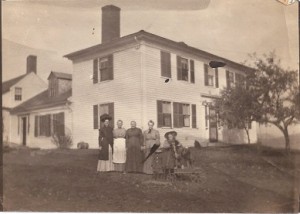
I have, on most occasions, an irreverent attitude toward my family history. I think the critical details of names, dates, and places are the foundation of any genealogical research, but beyond that it seems that those details can become ends in themselves. After years of traditional genealogical research, I try not to be caught up in the web of endless searching for this date, or that place; rather, I try to focus on the stories in the mêlée of my heritage. I’m seldom disappointed by the individual day-to-day lives; disappointment comes with the lack of information about them, even if it’s just an unnamed couple in a tintype. Continue reading Witches and traitors and saints, oh, my!
Loyalist ancestors
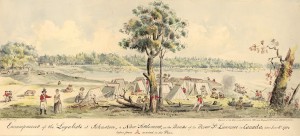
Mabel Winters, my great-grandmother, left Yarmouth County, Nova Scotia, when she was about eighteen or nineteen years old. She arrived in the United States about 1900, and first lived with her older brother George in Norton, Bristol County, Massachusetts. I have heard many wonderful stories about Mabel, and I wanted to learn everything that I could about her. As I began to research her life in Nova Scotia, I discovered that she was descended from several Loyalist families. Continue reading Loyalist ancestors
Vive la Reine!
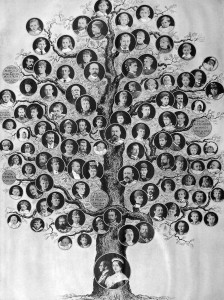
Later on today, Queen Elizabeth II’s reign will surpass the reign of her great-great-grandmother Queen Victoria in length. While the British throne has known many monarchs of short duration – the queen’s uncle, King Edward VIII (1936), comes readily to mind – it is interesting to note that the House of Hanover/Saxe-Coburg-Gotha/Windsor has produced a king and two queens who ruled for more than fifty years each: George III (1760–1820, 59 years and 96 days), Victoria (1837–1901, 63 years and 216 days), and Elizabeth II (1952–, 63 years and 215 days … and counting).[1] Continue reading Vive la Reine!
Making progress by breaking with tradition

As an avid genealogical researcher, I am keenly aware of the role that tradition plays in history. In all cultures, each new generation largely expects to follow traditions set by their predecessors, often without much thought as to why. Asking why is important. Challenging tradition brings progress. Haven’t the advances in civil rights over the past 100 years come largely from challenging tradition?
Recently I saw a discussion on Facebook on the tradition of a woman taking her husband’s last name upon marriage. A friend who had chosen to keep her birth name commented that she didn’t see any reason to change her name; she thought the tradition was outdated and paternalistic. I agreed, but I couldn’t help but notice that while she had kept her surname, both her son and daughter had their father’s last name. This has always been a tradition with which I had been uneasy, but until now I hadn’t been able to come up with a better alternative. Continue reading Making progress by breaking with tradition
How to keep a surname going?

Reading Scott Steward’s post about surnames being changed to keep another family name going reminded me of two examples we encountered when we wrote The Descendants of Judge John Lowell of Newburyport, Massachusetts together.
The first example is relatively straightforward. This involved the descendants of the poet James Russell Lowell (1819–1891). James had three daughters and one son, but only his daughter Mabel survived childhood. She married Edward Burnett and had three sons – James Russell Lowell Burnett (b. 1873), Joseph Burnett (b. 1874), and Francis Lowell Burnett (b. 1878). In 1890, Mabel’s eldest son James had his name changed to James Burnett Lowell to continue his maternal grandfather’s surname. Continue reading How to keep a surname going?